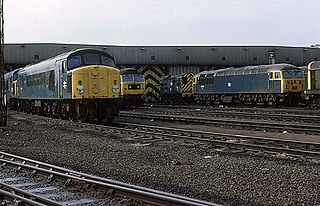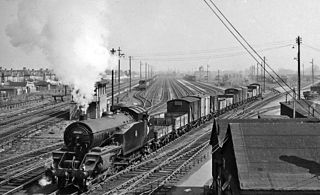
Severn Tunnel Junction railway station is a minor station on the western side of the Severn Tunnel in the village of Rogiet, Monmouthshire, Wales. It is 123.5 miles (198.8 km) from London Paddington and lies at the junction of the South Wales Main Line from London and the Gloucester to Newport Line.

A rail yard, railway yard, railroad yard (US) or simply yard, is a series of tracks in a rail network for storing, sorting, or loading and unloading rail vehicles and locomotives. Yards have many tracks in parallel for keeping rolling stock or unused locomotives stored off the main line, so that they do not obstruct the flow of traffic. Cars or wagons are moved around by specially designed yard switcher locomotives (US) or shunter locomotives (UK), a type of locomotive. Cars or wagons in a yard may be sorted by numerous categories, including railway company, loaded or unloaded, destination, car type, or whether they need repairs. Yards are normally built where there is a need to store rail vehicles while they are not being loaded or unloaded, or are waiting to be assembled into trains. Large yards may have a tower to control operations.

Aston railway station serves the districts of Aston and Nechells in Birmingham, England. The passenger entrance is on Lichfield Road. The station is on the Cross-City Line and the Chase Line. It is one of two local stations for Aston Villa Football Club and near to the Aston Expressway and to Gravelly Hill Interchange.

Tinsley was a railway marshalling yard near Tinsley in Sheffield, England, used to separate railway wagons from incoming trains and add them to new trains. It was sited immediately west of the M1 motorway, about one mile north of the Catcliffe junction. It was opened in 1965, as a part of a major plan to rationalise all aspects of the rail services in the Sheffield area; it closed in stages from 1985, with the run-down of rail freight in Britain. It was also the site of Tinsley Traction Maintenance Depot (TMD), which was closed in 1998; at its peak, 200 locomotives were allocated to this depot.

Bescot TMD is a locomotive traction maintenance depot in the West Midlands, England. Situated adjacent to Bescot Stadium railway station, the depot with code BS is currently operated by DB Schenker Rail (UK). Bescot Yard is to the south-east of the depot. This entire complex of track is clearly visible from the northern end of the M6 and M5 motorway junction.

Toton Traction Maintenance Depot or Toton Sidings is a large traction maintenance depot located in Toton, Nottinghamshire. The TOPS depot code for the depot is TO. Before TOPS, the shed code was 16A.

Dollands Moor Freight Yard is a railway freight yard near Folkestone in Kent, and was purpose built in 1988 for the Channel Tunnel. It is to the west of the Eurotunnel Folkestone Terminal, and just to the south of the M20 Motorway.
Sarsden Halt was an unstaffed railway station on the Banbury and Cheltenham Direct Railway.

Feltham marshalling yard, also known as Feltham hump yard, was a large railway marshalling yard designed for the concentration of freight traffic to and from South West London, and for transfer to other marshalling yards in London. It was built on the Waterloo to Reading Line. It opened in 1918 and was closed by British Railways on 6 January 1969.

Bescot Yard is a railway yard in Bescot, a suburb of Walsall in the West Midlands, operated by DB Cargo UK. The yard is the major freight yard of the region, handling all of the rail freight movements and most of the railfreight traffic around the West Midlands.
In rail freight transportation the terms wagonload or wagonload freight refer to trains made of single wagon consignments of freight. In the US and Canada the term carload refers to a single car of any kind, and manifest train refers to trains made of diverse cars of freight.

Tees Marshalling Yard is a railway marshalling yard, used to separate railway wagons, located near Middlesbrough in North Yorkshire, Northern England.

Dresden-Friedrichstadt station is a freight yard that is, along with the two passenger stations of Dresden Hauptbahnhof and Dresden-Neustadt, a central component of the railway node of Dresden in the German state of Saxony. The station precinct, which is located in the Dresden district of Friedrichstadt, also includes a locomotive depot and a regional passenger station.

Healey Mills Marshalling Yard was a railway marshalling yard located in the village of Healey, south west of Ossett in West Yorkshire, England. The yard was opened in 1963 and replaced several smaller yards in the area. It was part of the British Transport Commission's Modernisation plan, and so was equipped with a hump to enable the efficient shunting and re-ordering of goods wagons. The yard lost its main reason for existence through the 1970s and 1980s when more trains on the British Rail system became block trains where their wagons required less, or more commonly, no shunting.

Basford Hall Yard is a railway marshalling yard near the town of Crewe, Cheshire, England. The yard, which is 0.93 miles (1.5 km) south of Crewe railway station, was opened in 1901 by the London and North Western Railway (LNWR). Initially used to marshal trains, the site now acts as a hub mainly for Freightliner intermodal trains, but also houses departmental sidings as used by Freightliner Heavy Haul, and other operators. For a period in the 1930s, Basford Hall was the busiest marshalling yard in Europe, handing between 28,000 and 47,000 wagons every week.

Dringhouses Yard was a railway freight marshalling yard on the East Coast Main Line (ECML), south of York railway station in England. The yard was built during the First World War to help with the increase in traffic caused by the support to the British war effort. The yard was modernised in the 1960s, being fitted with a hump (knuckle), to ease shunting operations. It was closed to all traffic in 1987 after the loss of local railfreight traffic around York.

Milford Sidings are a set of railway sidings in South Milford, North Yorkshire, England. The railways through the site were initially opened in 1834 and 1840, when transfer and marshalling yards opened too, which handled mostly coal. However, the current sidings were developed in the 1980s to function as layover sidings for coal trains to and from the Aire Valley power stations. The sidings have access to several railway lines radiating in almost all directions.
Perth New Yard is a former railway marshalling yard in the city of Perth, Scotland. The yard was built in the early 1960s to gather traffic from around the Perth area and goods wagons from the lines radiating from Perth. It was latterly used as an engineering and wagon storage depot until it was finally closed in 2008. Though abandoned, the site is registered with Canmore, the Historic Environment Scotland.

















